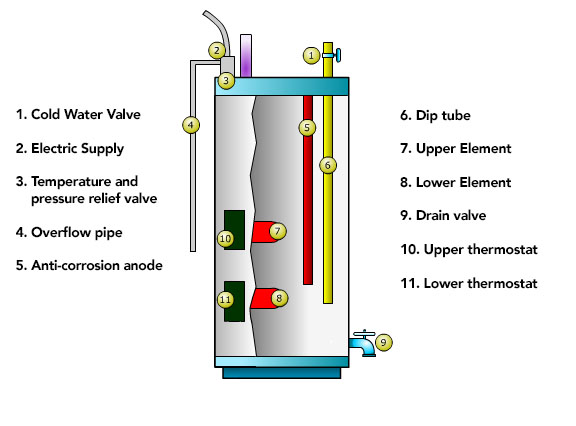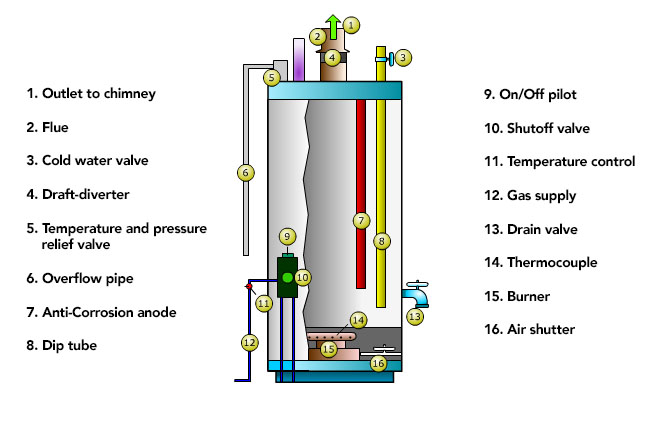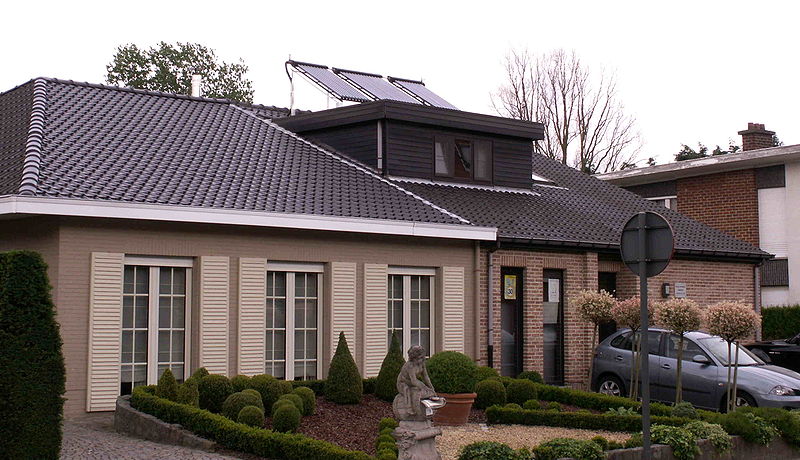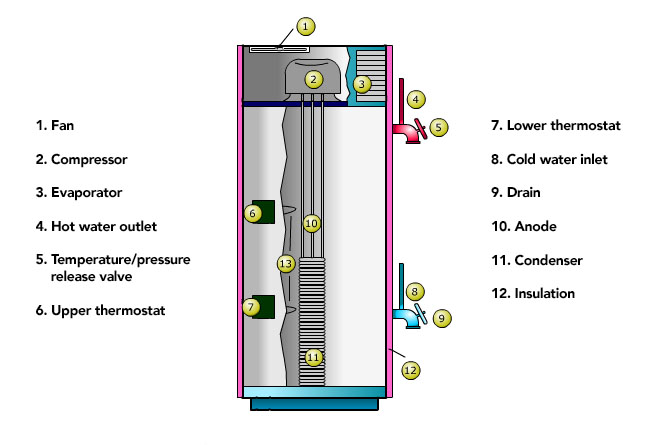5.3: Water Heaters
- Page ID
- 47179
Heat is continuously flowing from the tank of the water heater and the pipes to the room because the water heater is always at a higher temperature than the surroundings (basement or garage). Thermal energy flows from high temperature to low temperature. Heat is lost whether you use water or not.
Like most appliances, water heaters have improved greatly in recent years. Today's models are much more energy efficient, and you will be able to purchase a more efficient water heater that will save you money on energy each month. The average life expectancy of a water heater is 13 years. Therefore, the initial purchase price should not be an important factor in selecting a water heater.
Costs of Water Heaters
Just like other appliances, there are two costs associated with water heaters - initial purchase price and operating costs. Water heaters typically last for about 13 years, after which they need to be replaced. Also, each month, you pay for the fuel you use. An energy-efficient model could save hundreds of dollars in the long run in the energy costs and may offset the higher initial purchase price.
It can be compared to automobile mileage—some cars get 15 miles to a gallon, while other, more efficient, vehicles can go 30 miles or more on a gallon of gas. In the same way, some water heaters use energy more efficiently.
One should buy an energy-efficient water heater and spend less money each month to get the same amount of hot water.
Typical Water Use at Home
Table 5.3.1 shows typical water use for various purposes at home.
Table 5.3.1. Typical water use
| Use | Gallons per use |
|---|---|
| Shower | 7 to 10 |
| Bath (standard tub) | 20 |
| Bath (whirlpool tub) | 35 to 50 |
| Clothes washer (hot water wash, warm rinse)2 | 32 |
| Clothes washer (warm wash, cold rinse) | 7 |
| Automatic dishwasher | 8 to 10 |
| Food preparation and cleanup | 5 |
| Personal (hand-washing, etc.) | 2 |
Energy costs increase with water temperature. Dishwashers require the hottest water of all household uses, typically 135ºF to 140ºF. However, these devices are usually equipped with booster heaters to increase the incoming water temperature by 15ºF to 20ºF. Setting the water heater between 120ºF and 125ºF and turning the dishwasher’s booster on should provide sufficiently hot water while reducing the chances for scalding.
Energy Required for Water Heating
To calculate the amount of energy required for water heating, use the equation
\[ Q = m * C_p * \Delta T \]
where
- \( m \) = mass of water heated
- \( C_p \) = the heat capacity of water (1 BTU / lb ºF)
- \( \Delta T \) = temperature difference
Important Point
Remember to make your units of measurements consistent. Since Cp is measured in pounds, your mass of water heated should be measured in pounds as well. Thus, if you only know the number of gallons, you must convert it into pounds. One gallon of water = about 8.3 pounds, so multiply number of gallons by 8.3 to determine the weight in pounds.
Example Problems
Example 1
It is estimated by the United States Department of Energy that a family of four each showering for 10 minutes a day consumes about 700 gal of hot water a week. Water for the showers comes into the home at 55ºF and needs to be heated to 120ºF. What is the cost of gas vs. electricity to power this home, and which is more expensive?
- Answer
-
Determine the variables for equation 5.3.1:
- m = mass of water heated = 700 gallons = 5810 lbs
- Cp = heat capacity of water = 1 BTU/lb ºF (given)
- ΔT = temperature difference = 120 - 55 = 65ºF
The heat energy required to heat 700 gal can be calculated as follows:
\[ Heat = 5810 \, lbs * \dfrac{1 BTU}{lb ºF} * 65ºF = 377650 \, BTU/week \nonumber\]
Then, the heat required for one year is
\[ Heat \, (1 \, year) = \dfrac{377650 BTU}{week} * \dfrac{52 weeks}{year} = 19,637,800 \, BTU/year = 5755 \, kWh \nonumber\]
Assuming that the natural gas costs $10/MMBTU (1 MMBTU = 1,000,000 BTU) and electricity costs $0.092 per kWh, the gas costs would be $196.37 while electric costs would be $529.46. Clearly, electric heat is more expensive than natural gas.
Example 2
Estimate the % energy savings of an electric water heater that heats 100 gallons of per day when the temperature is set back at 110°F instead of 120°F. The basement is heated and is at 65°F. The life of the water heater is expected to be about 10 years. Use an appropriate cost for electricity and compare the operating expenses.
- Answer
-
Calculate the energy required for heating the water to 120°F by using equation 5.3.1:
\[ Energy = \underbrace{ \dfrac{100 gal}{day} * \dfrac{8.3 lb}{gal} }_m * \underbrace{ \dfrac{1 BTU}{lb °F} }_{C_p} * \underbrace{ (120 - 65)°F }_{\Delta T} = 45,650 \, BTUs/day \nonumber\]
In one year,
\[ Energy \, (per \, year) = \dfrac{45,650 \, BTUs}{day} * \dfrac{365 \, days}{year} = 16,662,250 \, BTUs/year \nonumber\]
In a 10-year period,
\[ Energy \, (per \, 10 \, years) = \dfrac{16,662,250 \, BTUs}{year} * 10 \, years = 166,622,500 \, BTUs \nonumber\]
This is equivalent to 48,834 kWh (since 1 kWh = 3,412 BTUs).
The operating cost over its lifetime is
\[ Operating \, cost = 48,834 \, kWh * \dfrac{\$0.09}{kWh} = \$4,395.06 \nonumber\]
Now, calculate the energy required for heating the water to 110°F by using equation 5.3.1:
\[ Energy = \underbrace{ \dfrac{100 gal}{day} * \dfrac{8.3 lb}{gal} }_m * \underbrace{ \dfrac{1 BTU}{lb °F} }_{C_p} * \underbrace{ (110 - 65)°F }_{\Delta T} = 37,350 \, BTUs/day \nonumber\]
In one year,
\[ Energy \, (per \, year) = \dfrac{37,350 \, BTUs}{day} * \dfrac{365 \, days}{year} = 13,632,750 \, BTUs/year \nonumber\]
In a 10-year period,
\[ Energy \, (per \, 10 \, years) = \dfrac{13,632,750 \, BTUs}{year} * 10 \, years = 136,327,500 \, BTUs \nonumber\]
This is equivalent to 39,995 kWh (since 1 kWh = 3,412 BTUs).
The operating cost over its lifetime is
\[ Operating \, cost = 39,995 kWh * \dfrac{\$0.09}{kWh} = \$3,595.95 \nonumber\]
The estimated % energy savings are
\[ Savings = \$4,395.06 - \$3,595.95 = \$799.11 \nonumber\]
\[ \% \, Savings = \dfrac{\$799.11}{\$4,395.06} = \mathbf{18.2\% \, savings} \nonumber\]
Types of Water Heaters: Storage or Tank
There are several types of water heaters that are available on the market:
- Storage or tank
- On demand
- Heat pump
- Tankless coil
- Indirect
- Solar
However, most water heaters use a storage tank type.
Storage or tank-type water heaters are relatively simple devices and by far the most common type of residential water heater used in the United States. They range in size from 20 to 80 gallons, and can be fueled by electricity, natural gas, propane, or oil.
Parts of an Electric Hot Water Heater
Figure 5.3.1 breaks down the parts of an electric water heater.

Figure 5.3.1. Electric hot water heater
Parts of a Gas Hot Water Heater
Figure 5.3.2 breaks down the parts of a gas hot water heater.

Figure 5.3.2. Gas hot water heater
How a Gas Hot Water Heater Works
When you turn on a hot water faucet or use hot water in a dishwasher or clothes washer, water pipes draw hot water from the tank. To replace that hot water, cold water enters the bottom of the tank, ensuring that the tank is always full. Depending on the type of fuel that is used, either electrical heating elements or a natural gas burner is used to heat the water.
The following video shows an animation of how a gas water heater works.
Credit: Dr. Sarma Pisupati
Electric water heaters are generally less expensive to install (purchase price) than gas-fired types because they don't require gas lines and vents to let the combustion products out of the house. In previous lessons, and in Home Activity 2, we have seen that natural gas costs about 7–12 dollars per million BTUs, whereas electrical energy is 20–25 dollars per million BTUs, making electric water heaters more expensive to operate.
Storage tank-type water heaters raise and maintain the water temperature to the temperature setting on the tank (usually between 120°–140°F). Because the water is constantly heated and kept ready for use in the tank, heat energy can be lost even when no faucet is on. This is called standby heat loss. These standby losses represent 10 to 20 percent of a household's annual water heating costs. Newer, more energy-efficient storage models can significantly reduce the amount of standby heat loss, making them much less expensive to operate.
Types of Water Heaters: Demand Water Heaters
Demand Water Heaters do not have storage tanks, so there is no standby heat loss from the tank, and energy consumption is reduced by 20 to 30 percent. Demand water heaters are available in propane (LP), natural gas, or electric models.
In these types of water heaters, cold water travels through a pipe into the unit, and either a gas burner or an electric element heats the water only when needed. With these systems, you never run out of hot water. However, the flow rate is limited by the outlet temperature.
The appeal of demand water heaters is the elimination of the tank standby losses, the resulting lower operating costs, and the fact that the heater delivers hot water continuously.
How a Demand Water Heater Works
The following video explains how a demand water heater works.
Typically, demand heaters provide hot water at a rate of 2 to 4 gallons per minute. This flow rate might meet the requirements of a household's hot water needs as long as the hot water is not needed in more than one location at a time (e.g., one cannot shower and do the laundry simultaneously). To meet hot water demand when multiple faucets are being used, demand heaters can be installed in parallel sequence.
Although gas-fired demand heaters tend to have higher flow rates than electric ones, they can waste energy even when no water is being heated if their pilot lights stay on. However, the amount of energy consumed by a pilot light is quite small. Thus, in most cases, gas demand water heaters will cost less to operate than electric water heaters.
Demand water heaters cost more than conventional storage tank-type units. Small point-of-use heaters that deliver 1 to 2 gallons per minute (gpm) sell for about $200. Larger gas−fired demand units that deliver 3 to 5gpm cost $550 - $1,000. The more hot water the unit produces, the higher the cost.
Advantages and Disadvantages of Demand Water Heaters
Table 5.3.2 details the advantages and disadvantages.
Table 5.3.2. Advantages and disadvantages of demand water heaters
| Advantages | Disadvantages |
|---|---|
|
|
Types of Water Heaters: Solar Water Heaters
An estimated one million residential and 200,000 commercial solar water-heating systems, shown in Figure 5.3.3, have been installed in the United States. Although there are a large number of different types of solar water-heating systems, the basic technology is very simple.
Sunlight strikes and heats an "absorber" surface within a "solar collector" or an actual storage tank. These roof-mounted solar heaters supply about 80% of the hot water for the home. Either a heat-transfer fluid or the actual potable water to be used flows through tubes attached to the absorber and picks up the heat from it. (Systems with a separate heat-transfer-fluid loop include a heat exchanger that then heats the potable water.) The heated water is stored in a separate preheat tank or a conventional water heater tank until needed.
If additional heat is needed, it is provided by electricity or fossil-fuel energy by the conventional water-heating system.

Figure 5.3.3. A roof mounted solar water heater
Credit: Work found at http://en.Wikipedia.org/wiki/File:ThermodynamicPanelsInstalled.jpg
How a Solar Water Heater Works
The following video explains how a solar water heater operates.
By reducing the amount of heat that must be provided by conventional water heating, solar water-heating systems directly substitute renewable energy for conventional energy, reducing the use of electricity or fossil fuels by as much as 80%.
Today's solar water-heating systems are proven reliable when correctly matched to climate and load. The current market consists of a relatively small number of manufacturers and installers that provide reliable equipment and quality system design.
A quality assurance and performance-rating program for solar water-heating systems, instituted by a voluntary association of the solar industry and various consumer groups, makes it easier to select reliable equipment with confidence.
Building owners should investigate installing solar hot water-heating systems to reduce energy use. However, before sizing a solar system, water-use reduction strategies should be put into practice.
Types of Solar Hot Water Heaters
There are five types of solar hot water systems:
- Thermosiphon Systems. These systems heat water or an antifreeze fluid, such as glycol. The fluid rises by natural convection from collectors to the storage tank, which is placed at a higher level. No pumps are required. In thermosiphon systems, fluid movement, and therefore heat transfer, increases with temperature, so these systems are most efficient in areas with high levels of solar radiation.
- Direct-Circulation Systems. These systems pump water from storage to collectors during sunny hours. Freeze protection is obtained by recirculating hot water from the storage tank, or by flushing the collectors (drain-down). Since the recirculation system increases energy use, while flushing reduces the hours of operation, direct-circulation systems are used only in areas where freezing temperatures are infrequent.
- Drain-Down Systems. These systems are generally indirect water-heating systems. Treated or untreated water is circulated through a closed loop, and heat is transferred to potable water through a heat exchanger. When no solar heat is available, the collector fluid is drained by gravity to avoid freezing and convection loops in which cool collector water reduces the temperature of the stored water.
- Indirect Water-Heating Systems. In these systems, freeze-protected fluid is circulated through a closed loop and its heat is transferred to potable water through a heat exchanger with 80 to 90 percent efficiency. The most commonly used fluids for freeze protection are water-ethylene glycol solutions and water-propylene glycol solutions.
- Air Systems. In this indirect system, the collectors heat the air, which is moved by a fan through an air-to-water heat exchanger. The water is then used for domestic or service needs. The efficiency of the heat exchanger is in the 50% range.
Direct-circulation, thermosiphon, or pump-activated systems require higher maintenance in freezing climates. For most of the United States, indirect air and water systems are the most appropriate. Air solar systems, while not as efficient as water systems, should be considered if maintenance is a primary concern since they do not leak or burst.
Types of Water Heaters: Heat Pump Water Heaters (HPWHs)
Heat pumps are a well-established technology for space heating. The same principal of transferring heat is at work in HPWHs except that they extract heat from air (indoor, exhaust, or outdoor air) and deliver it to water. Some models come as a complete package, including tank and back-up resistance heating elements, while others work as an adjunct to a conventional water heater.
The simplest HPWH is the ambient air-source unit, which removes heat from surrounding air, providing the additional benefit of space cooling. Exhaust air units extract heat from a continuously exhausted air stream and work better in heating-dominated climates because they do not cool ambient air. Some units can even be converted between the two modes of operation for optimum operation in either summer or winter.
In mild climates, you can place ambient air-source units in unheated but protected spaces such as garages, essentially using outdoor air as a heat source.
Important Point
Because it extracts heat from air, the HPWH delivers about twice the heat for the same electricity cost as a conventional electric resistance water heater.
Parts of a HPWH
Figure 5.3.4 shows the components of a HPWH.

Figure 5.3.4. Heat pump water heater parts
Desuperheaters
The Desuperheater feature is available on some central air conditioners and is a variation of the stand-alone HPWH. It provides economical supplemental water heating as a byproduct of air conditioning.
Desuperheater water heating can be part of an integrated package with a heat pump or air conditioner system. In most such systems, the heat pump water heating only occurs during normal demand for space conditioning, with resistance electric coils providing water heating the rest of the time.
During the cooling season, the Desuperheater actually improves the efficiency of the air conditioning system while heating water at no direct cost. In an average climate, a desuperheater might meet 20 to 40 percent of annual water heating demand.
Heat pump water heaters can provide up to 60 percent energy savings over conventional water heaters.
How a HPWH Works
The HPWH consists of three circuits. The HPWH consists of three circuits. The following video explains more about how a HPWH works.
Credit: Dr. Sarma Pisupati
Note: The concept shown in the animation is applicable to all HPWH: heat is picked up and delivered into some source – which could either be the ground, air, or water.
Most of the heat delivered to the water comes from the evaporator of the unit, not through the electrical input to the machine. Consequently, the efficiency of the HPWH is much higher than for direct-fired gas or electric storage water heaters.
The installed cost of commercial HPWH systems is typically several times that of gas or electric water heaters; yet the low operating costs can often offset the higher total installed cost, making the HPWH the economic choice for water heating.
The HPWH becomes increasingly attractive in building applications where energy costs are high, and where there is a steady demand for hot water. This attractiveness is less a function of building type than it is of water demand and utility cost.
Energy Efficiency of Water Heaters
The federal efficiency standards for water heaters took effect in 1990, assuring consumers that all new water heaters meet certain minimum-efficiency levels. New standards, which took effect in January 2004, will increase the minimum efficiency levels of these products.
Water heater efficiency is reported in terms of the energy factor (EF). EF is an efficiency ratio of the energy supplied in heated water divided by the energy input to the water heater, and it is based on recovery efficiency, standby losses, and cycling losses. The higher the EF, the more efficient the water heater.
- Electric resistance water heaters have EFs ranging from 0.7 and 0.95.
- Gas water heaters from 0.5 and 0.6, with some high-efficiency models ranging around 0.8.
- Oil water heaters from 0.7 and 0.85.
- Heat-pump water heaters from 1.5 to 2.0.
Additional Information
There is little difference between the most efficient electric resistance storage water heaters and the minimum-efficiency standard that will take effect in January 2004. If you need to rely on electricity to heat your water, keep your eye out for the further development of heat-pump water heaters. This technology uses one-third to one-half as much electricity as a conventional electric resistance water heater.
Energy Efficiency Recommendations
Everything else being equal, select a water heater with the highest energy factor (EF). Table 5.3.3 energy efficiency recommendations.
Table 5.3.3. Water heater energy efficiency recommendations
| Storage Type | Recommended | Best Available | ||
|---|---|---|---|---|
| Energy Factor | Annual Energy Use (kWh) | Energy Factor | Annual Energy Use (kWh) | |
| Less than 60 gallons | 0.93 | 4.721 | 0.95 | 4,622 |
| 60 gallons or more | 0.91 | 4.825 | 0.92 | 4,773 |
Important Point
The higher the EF, the more efficient the water heater.
Other Considerations
In addition to EF, also look for a water heater with at least one-and-a-half inches of tank insulation and a heat trap.
In addition, capacity of a water heater is an important consideration. The water heater should provide enough hot water at the busiest time of the day. For example, a household of two adults may never use more than 30 gallons of hot water in an hour, but a family of six may use as much as 70 gallons in an hour.
The ability of a water heater to meet peak demands for hot water is indicated by its "first hour rating." This rating accounts for the effects of tank size and the speed by which cold water is heated. Water heaters must be sized properly. Over-sized water heaters not only cost more but increase energy use due to excessive cycling and higher standby losses.
Life Cycle Analysis

Figure 5.3.5. EnergyGuide labels for two different water heaters
Water Heaters: Your "Power" in Enviromental Protection
Here are some things you can do to minimize the environmental impact of your water heater.
- Do as much cleaning as possible with cold water to save the energy used to heat water.
- Check your faucets for leaks. They waste both water and energy!
- Conserve hot water by installing water-saving showerheads. A new showerhead can save as much as $10 a year in water and energy.
- Once your water is hot, insulate to help keep it that way. Wrapping exposed hot water pipes with insulation will minimize heat loss. So will installing an R-12 insulation blanket around your water heater, unless the manufacturer does not recommend it.
- Reduce your water heater's temperature to 120 degrees Fahrenheit. That will produce plenty of hot water and still save energy. For homes with a dishwasher, a setting of 140 degrees is required to clean properly, but most of the new dishwashers have a built-in water temperature booster.
- Many new water heaters have a "vacation" setting you can use to save energy if you're away for more than a few days. Turn the thermostat "down" or "off" when you're gone for more than three days.


